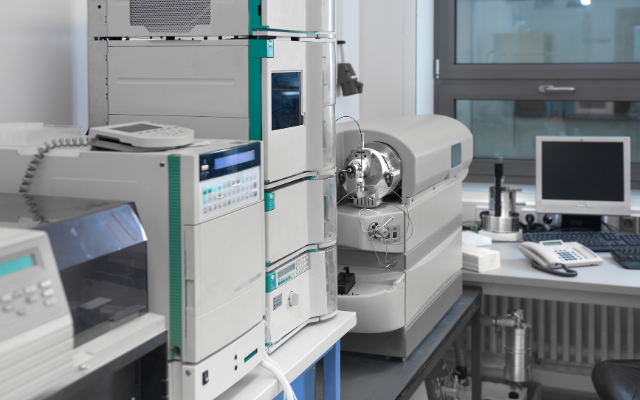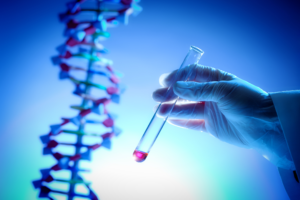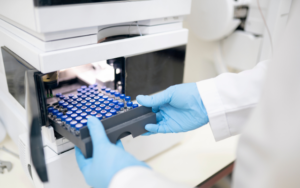Welcome to our comprehensive guide on Mass Spectrometry, a powerful analytical technique that has revolutionized the scientific world. From understanding the basic principles to its diverse applications, we’ll delve into the wonders of Mass Spectrometry and how it impacts various fields of research and industry. So, let’s embark on this journey of discovery together!
Mass Spectrometry (MS) is an analytical technique used to identify and quantify the chemical composition of a sample based on the mass-to-charge ratio of its ions. It involves ionizing the sample, separating the ions based on their mass, and then detecting them to generate a mass spectrum. This spectrum provides crucial information about the molecular structure and composition of the sample.
Table of Contents
The Fundamental Principles of Mass Spectrometry

Mass spectrometry (MS) is a powerful analytical technique that has transformed the fields of chemistry, biology, and beyond. By analyzing the mass-to-charge ratio of ions, MS enables researchers to identify and quantify the composition of diverse samples with unparalleled precision. In this blog post, we will unravel the fundamental principles that underpin the magic of mass spectrometry, shedding light on the intricacies of this remarkable scientific tool.
Ionization – The Starting Point
The first step in mass spectrometry involves ionization, wherein neutral molecules are converted into charged ions. This process can be achieved through different methods such as Electrospray Ionization (ESI), Matrix-Assisted Laser Desorption/Ionization (MALDI), and Electron Impact (EI). Ionization renders the sample suitable for analysis, setting the stage for the subsequent steps.
Mass Analyzer – Sorting Ions by Mass
The heart of any mass spectrometer lies in its mass analyzer. This component separates the ions based on their mass-to-charge (m/z) ratio, enabling the creation of a mass spectrum. There are various types of mass analyzers, including Time-of-Flight (TOF), Quadrupole, Ion Trap, and Magnetic Sector analyzers, each with its unique advantages and applications.
Detection – Capturing the Ions
Once separated, the ions need to be detected to generate the mass spectrum. Modern detectors like Electron Multiplier Tubes (EMTs) and Microchannel Plates (MCPs) are highly sensitive and enable accurate measurements of ion abundance.
Mass Spectrum – The Key to Information
The resulting mass spectrum is a graph displaying the intensity of ions as a function of their m/z ratio. Each peak corresponds to a specific ion, revealing valuable information about the molecular composition and structure of the sample.
Mass-to-Charge Ratio – A Crucial Parameter
The m/z ratio is a fundamental parameter in mass spectrometry, representing the mass of an ion divided by its charge. This ratio determines the position of the ion on the mass spectrum, enabling precise identification and analysis.
Mass Resolution – Unraveling Complex Samples
Mass resolution refers to the ability of a mass spectrometer to distinguish ions of slightly different m/z ratios. High mass resolution is essential for analyzing complex samples and identifying multiple components within them accurately.
Tandem Mass Spectrometry – Delving Deeper
Tandem mass spectrometry (MS/MS) involves a two-step process where ions are first selected and then fragmented to yield product ions. By analyzing these product ions, researchers gain deeper insights into the molecular structure and sequence of the sample.
Isotope Ratio Mass Spectrometry – Tracing Origins
Isotope ratio mass spectrometry (IRMS) measures the ratios of stable isotopes, such as carbon-13 and carbon-12. This technique is particularly valuable in tracing the origin and authenticity of substances, like detecting counterfeit drugs or investigating archaeological artifacts.
High-Resolution Mass Spectrometry – Advancing Precision
High-resolution mass spectrometry (HRMS) employs mass analyzers with superior resolving power, allowing for precise measurement of small mass differences. HRMS is widely used in proteomics, metabolomics, and environmental studies.
Applications of Mass Spectrometry

Mass Spectrometry (MS), also known as Mass Spectroscopy, is a powerful analytical technique that has transformed the scientific landscape. Its ability to analyze the mass and composition of ions in a sample has led to numerous groundbreaking applications across various fields. In this blog post, we will explore ten key areas where Mass Spectrometry plays a pivotal role, revolutionizing research, industry, and healthcare.
Proteomics: In the realm of biology and medicine, Mass Spectrometry is a cornerstone of proteomics, the study of proteins. It allows scientists to identify and analyze proteins, understand their functions, interactions, and post-translational modifications. This knowledge is instrumental in drug development, disease research, and personalized medicine.
Pharmaceuticals: The pharmaceutical industry relies heavily on MS to analyze drug compounds for purity, stability, and pharmacokinetic properties. Mass Spectrometry enables the precise determination of drug metabolites, facilitating drug safety evaluations and improving therapeutic efficacy.
Environmental Analysis: Mass Spectrometry is crucial in environmental monitoring and analysis. It aids in detecting and quantifying pollutants, pesticides, and toxins in air, water, and soil samples. By assessing environmental impacts, MS contributes to safeguarding our planet’s health.
Forensic Investigations: Forensic scientists use Mass Spectrometry to analyze trace evidence, such as drugs, explosives, and bodily fluids found at crime scenes. This analytical technique plays a pivotal role in criminal investigations, ensuring justice is served.
Metabolomics: MS helps unlock the mysteries of metabolism by analyzing the metabolites present in biological systems. This knowledge is vital for understanding disease mechanisms, identifying biomarkers, and advancing precision medicine.
Food Safety and Quality: MS assists in food safety assessments by detecting contaminants, allergens, and adulterants in food products. It ensures the quality and integrity of the food supply chain, promoting consumer well-being.
Petroleum and Petrochemical Analysis: In the oil and gas industry, MS aids in characterizing and quantifying hydrocarbons, determining the composition of crude oil, and assessing the quality of petrochemical products.
Clinical Diagnostics: Mass Spectrometry is used for clinical diagnostics, enabling the quantification of biomarkers and therapeutic drug monitoring. It aids in early disease detection and monitoring treatment efficacy.
Metallurgy and Material Science: MS contributes to the analysis of metallic alloys, ceramics, and polymers, providing critical information about their composition and structure. This aids in material development and quality control.
Archaeology and Art Restoration: Mass Spectrometry has found applications in archaeology and art restoration. It helps identify the composition of ancient artifacts, pigments in artworks, and assists in preserving cultural heritage.
The remarkable applications of Mass Spectrometry, also known as Mass Spectroscopy, are shaping the world we live in today. From advancing medical research and drug development to safeguarding the environment and uncovering historical mysteries, this analytical technique has become an indispensable tool in numerous fields. With ongoing advancements in technology and methodologies, Mass Spectrometry’s influence will continue to expand, leading to more discoveries and innovations that benefit humanity as a whole.
Benefits and Advancements of Mass Spectrometry

Mass Spectrometry, often referred to as Mass Spectroscopy, is a powerful analytical technique that has transformed the landscape of scientific research. This sophisticated method provides valuable insights into the molecular composition of substances and has found applications across various fields. In this blog post, we will explore the multitude of benefits offered by Mass Spectrometry and delve into some of the recent advancements that have further elevated its capabilities.
Unparalleled Sensitivity
One of the most remarkable advantages of Mass Spectrometry is its unparalleled sensitivity. It can detect even trace amounts of substances, making it a vital tool in fields such as forensics, environmental monitoring, and pharmaceutical research. With its ability to analyze samples at the molecular level, Mass Spectrometry has opened doors to new dimensions of discovery.
Quantitative Analysis
Mass Spectrometry enables precise quantification of compounds within a sample. Researchers and scientists can accurately determine the concentration of specific molecules, facilitating drug development, environmental assessments, and the study of metabolic processes in living organisms.
Structural Elucidation
Advancements in Mass Spectrometry techniques, particularly tandem mass spectrometry (MS/MS), have revolutionized structural elucidation. Scientists can now analyze complex molecular structures, aiding in the identification of unknown compounds and providing invaluable insights into chemical interactions.
High Throughput Capabilities
In recent years, Mass Spectrometry has made significant strides in high-throughput analysis. Automated sample handling, innovative ionization techniques, and data processing advancements have dramatically increased the speed and efficiency of data acquisition, significantly accelerating scientific research.
Versatility and Multidisciplinary Applications
Mass Spectrometry finds applications across a broad range of disciplines, including proteomics, metabolomics, environmental science, and materials research. Its versatility allows researchers to adapt the technique to suit their specific analytical needs.
Non-Destructive Analysis
Mass Spectrometry is a non-destructive technique, meaning the analyzed samples remain intact after analysis. This characteristic is particularly valuable when working with precious or limited samples, as it allows for further investigations and re-analysis.
Imaging Mass Spectrometry
Recent advancements in Mass Spectrometry have led to the development of Imaging Mass Spectrometry (IMS). This innovative technique enables the visualization of molecular distributions within biological tissues, opening new avenues for understanding disease pathologies and drug distribution in tissues.
Isotope Analysis
Mass Spectrometry plays a crucial role in isotope analysis, allowing scientists to determine the isotopic composition of elements within a sample. This capability is vital in fields like archaeology, environmental science, and geology for tracing the origins and movement of substances.
Real-time Monitoring
Advancements in Mass Spectrometry have paved the way for real-time monitoring applications. From monitoring chemical reactions to tracking pollutants in the environment, this capability has far-reaching implications in improving process efficiency and environmental protection.
Integration with Other Techniques
Mass Spectrometry can be seamlessly integrated with other analytical techniques, such as chromatography, to enhance the scope and accuracy of analysis. This synergistic approach has expanded the possibilities for research and has become a cornerstone in many scientific investigations.
Mass Spectrometry has emerged as an indispensable tool in modern scientific research and analysis. Its exceptional sensitivity, versatility, and recent advancements have propelled it to the forefront of various fields. As technology continues to evolve, Mass Spectrometry’s capabilities will only grow, unlocking new realms of discovery and innovation in the scientific community.
Through its applications in proteomics, metabolomics, environmental monitoring, and more, Mass Spectrometry continues to shape our understanding of the world around us and the molecules that compose it.
Future Perspectives of Mass Spectrometry

As we delve into the exciting realm of mass spectrometry, the future holds immense promise and potential for this cutting-edge analytical technique. Mass spectrometry has already revolutionized numerous scientific fields, including chemistry, biology, and medicine. However, advancements in technology and methodologies are set to propel mass spectrometry into even greater heights. One of the key future perspectives is the development of miniaturized and portable mass spectrometers, enabling rapid on-site analysis in various industries. This trend will streamline research processes, boost data acquisition efficiency, and open new avenues for real-time monitoring of chemical processes and environmental pollutants. Moreover, increased resolution and sensitivity are on the horizon, empowering researchers to unravel intricate molecular structures and identify trace compounds with unprecedented accuracy. As we look ahead, the integration of artificial intelligence and machine learning algorithms with mass spectrometry will significantly enhance data analysis, pattern recognition, and biomarker discovery, revolutionizing fields like personalized medicine and drug development. Embracing these technological advancements, the future of mass spectrometry is undoubtedly bright, heralding a new era of discovery and innovation.
Mass spectrometry, also known as mass spectroscopy, is at the forefront of scientific breakthroughs, and its future prospects are poised to shape the landscape of research and analysis profoundly. With a growing demand for fast, accurate, and sensitive analytical techniques, mass spectrometry is set to become an indispensable tool across a wide range of industries. The evolving field of mass spectrometry will witness remarkable developments in instrumentation, paving the way for enhanced resolution, extended mass range, and higher sensitivity. This progress will unlock a wealth of opportunities in fields such as proteomics, metabolomics, and environmental monitoring, enabling scientists to delve deeper into complex biological processes and better understand the chemical composition of various samples. Moreover, the convergence of mass spectrometry with complementary techniques like chromatography and ion mobility spectrometry will foster a comprehensive approach to analysis, further expanding the applications of this powerful analytical method. As we embrace these innovations, mass spectrometry will undoubtedly continue to empower researchers, clinicians, and industries alike, heralding a bright future of discovery and advancements.




